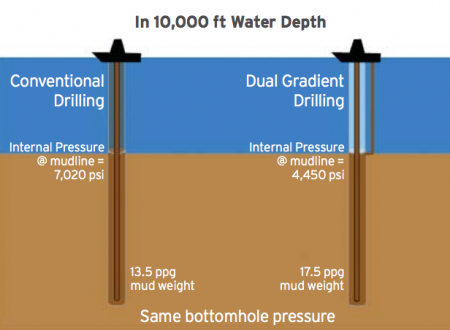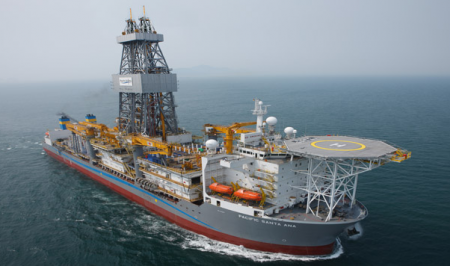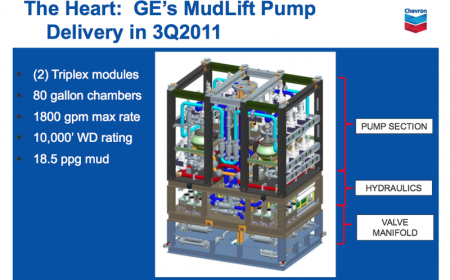May
8
Chevron is about to put the first deepwater drillship designed with the capacity to perform ‘dual gradient drilling’ to work. The ship is a Samsung 12000 design capable of operating in 12,000 ft (3,658 m) water depth and is equipped for 40,000 ft (12,192 m) drilling depth.
Able to work in 2 1/3rd miles deep water and over seven miles into the earth the new ship is a world leader. Named the Pacific Santa Ana the ship was built to Chevron’s specifications under a five-year contract with a subsidiary of Pacific Drilling S.A. She’s headed for the Gulf of Mexico. After additional equipment is installed and tested, Pacific Santa Ana will be used for exploratory and development drilling in the deepwater of the gulf.

Deepwater Drlling Prewssures With and Without Dual Gradient Design. Click image for the largest view.
Dual Gradient Drilling (DGD) employs two weights of drilling fluid (link to a Chevron presentation pf file). Conventional drilling on land and at sea uses a single drilling fluid weighted with additives in the borehole. DGD uses two weights of drilling fluid – one above the seabed, another below. This allows drillers to more closely match the pressures presented by nature and effectively eliminates water depth as a consideration in well design. DGD also allows drillers to more quickly detect and appropriately react to downhole pressure changes, which can enhance the safety and efficiency of deepwater drilling operations.
Deepwater wells in the Gulf of Mexico and other parts of the world including West Africa and the Caspian Sea are challenging due to the narrow pore pressure/fracture gradient environment. The DGD system gives operators a tool to manage the downhole environment while drilling, resulting in longer casing strings and/or larger diameter completions. The DGD system increases drilling efficiency while lowering mechanical risk and well costs.
The Pacific Santa Ana is equipped with a DGD riser, a mud-lift pump handling system, six mud pumps – three for drilling fluid and three for seawater – extensive fluid management system enhancements and more than 72,000 feet of DGD-related cables.
A key element of the system is the MaxLift 1800 mud-lift pump from GE. To achieve a dual gradient, flow from a well being drilled is diverted to the MaxLift 1800 pump, which is located above the blow out preventer and pumps the cuttings-laden mud back to the drilling vessel in an auxiliary line.
The riser is then filled with seawater density fluid, so the reservoir “feels” as if the rig is located on the seabed (that means essentially that the pressures are neutral at the seafloor taking out the pressure that causes a blowout to flow oil out to the environment) since the MaxLift pumps prevent the hydrostatic pressure of the mud from being transmitted back to the wellbore. The new GE pump can deliver up to 1,800 gpm at discharge pressures up to 6,600 psi and can handle solids up to 1.5 inches in diameter.
The consultation firm Stress Engineering Services report for the US Bureau of Ocean Energy Management, Regulation, and Enforcement in 2011 (a pdf download) explored the risk profile of DGD, noted that DGD is a variation and a subset of Managed Pressure Drilling (MPD), which is a drilling tool that is intended to resolve chronic drilling problems including well stability and well control incidents. MPD is intended to mitigate the risks and costs associated with drilling wells that have narrow downhole environmental limits by proactively managing the annular hydraulic pressure profile.
In the executive summary of the Stress Engineering Services report the firm points out, “Prior to April 20, 2010 (the date of the BP Deepwater Horizon explosion), the question of a catastrophic event was not a matter of “if”, but “when”. Drilling operations in a deepwater environment is an expensive endeavor. It is expensive for a number of reasons, but the chief reasons are to protect human life, equipment, and the wellbore in a very inhospitable environment. In a single pressure gradient environment (conventional drilling), it is easy to depart from the drilling window because of the narrow drilling window between the pore pressure and the formation fracture pressure. The Dual Gradient Drilling System re-establishes a margin of safety not obtainable in a single gradient system. Even the popular variant of Managed Pressure Drilling called Constant Bottomhole Pressure falls short of providing all of the well control benefits associated with DGD.”
“The most impressive aspect of Dual Gradient Drilling is that it is as safe or safer than current conventional drilling techniques AND provides for full riser margin, where the well is fully controlled in the event of riser disconnect AND problem wells can be drilled and completed instead of abandoned either with cement plugs or in a file labeled “TOO RISKY TO DRILL – TECHNOLOGY NOT AVAILABLE”.”
“…While there are risks associated with any drilling operation, deepwater well control is enhanced with DGD. Environmental episodes are also minimized. In the event of an emergency disconnect from the wellhead, seawater or a similarly compatible fluid dissipates into the surrounding water AND the well is under control because the hole is full of properly weighted drilling mud. DGD is like having a rig on the seabed floor. The riser margin is intact. It does not matter if the water depth is 5,000 feet or 15,000 feet, should the riser become disconnected, the well will be dead.”
One has to give Chevron credit for raw courage, something not seen in big corporate environments. Its likely the commitment for the building of the Pacific Santa Ana predated the BP Deepwater Horizon event, still Chevron has pressed on and is still pressing on in the face of a government playing shiftlessly on permits and permissions going so far as to deny pipeline applications. One cannot say with any honesty that the industry has held back on investing in producing oil.
Now, to rephrase the words of Stress Engineering, TECHNOLOGY IS AVAILABLE. Chevron is first with the Pacific Santa Ana and there are more ships readied to drill more wells even deeper.
Comments
2 Comments so far




What an intuitive solution to a real problem: if you have two different pressure environments – just operate at two different pressures.
[…] Source: Big Oil Chevron Ready to Drill Deeper and Safer Offshore […]